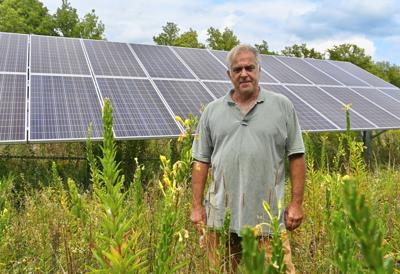WEYBRIDGE — Vermont’s solar farm developers are becoming more enamored with having sites double as habitat for bees and other pollinators.
According to Renewable Energy Vermont, this summer, Green Lantern Solar built its 20th pollinator-friendly site on a 4.5 acre property in New Haven. The company worked with Bee the Change, an organization based around Middlebury that works with solar developers to plant wildflowers and the like around solar farms.
“When we started in 2015, there really wasn’t much of a sense that pollinators were important or in trouble,” said Bee the Change founder Mike Kiernan. He said the hardships being faced by well-known “ambassador” species, such as honeybees and monarch butterflies, helped change that, along with studies and surveys backed by the United Nations showing troubling declines in bee populations in North America and Europe.
Kiernan said that 25 years ago one could find 17 species of bumblebee in Vermont, the most prevalent among them being the rusty patched bumblebee, which is endangered along with several others.
“Of those 17 species we had 25 years ago now we’re down to 10, and of the seven that are endangered four are gone,” said Kiernan. “It doesn’t matter what you build for habitat, they’re not coming back, and that’s an unprecedented rate of loss during the human time on this planet.”
Pollinators like bees are considered a “keystone” species, meaning they fill a role that many other species benefit from or depend on.
“This U.N. survey indicates this crisis is of equal importance as climate change when you look at the future of our food security and quality of life on the planet,” said Kiernan.
He said he’s pleased solar developers are interested in doing this work, since the longer it takes to become widespread, the fewer pollinators there will be to benefit from it.
“Solar developers are usually progressively-minded people, they want to do good things with their lives and work,” he said.
Chad Farrell, founder and chief executive officer of Encore Renewable Energy, said his company was among the first to incorporate pollinator-friendly ground cover into one of its projects — an array built in Hinesburg.
“We’re basically working on a policy that all of our projects will be completed with pollinator friendly ground cover,” he said. “We’ve been working hard to get our financing partners comfortable and on board with the concept of establishing pollinator friendly ground over at these sites.”
Creating a self-sustaining meadow around a solar field is not as simple or as cheap as it may sound, according to Farrell. The plantings need to be carefully managed to keep out invasive species and to not shade the arrays. It’s a higher upfront cost, but it’s hoped the benefit over the long run will be less maintenance.
Farrell said solar fields need to be mowed up to three times a year, which costs money and raises the risk of a panel being damaged by a stray rock or other debris. After a few years, however, the hope is the sites won’t need to be mowed as often or at all.
Farrell said his company likes to keep track of this in terms of acres rather than projects. In Vermont, Encore has about 40-acres of pollinator-friendly ground cover, and if one counts projects in development or under construction it’s about 110 acres. The company has 100 acres in New York and Pennsylvania.
He said he’s heard from people living near these sites that their gardens and flowers are doing better, as the pollinators don’t stick to a single site. Green Mountain Power has worked with Bee the Change on two of its sites one in Milton, the other in Ferrisburgh. “There is an extra cost up front, so you have to approach it differently, but we believe that over time we will see savings,” said Kristin Kelly, a spokeswoman for GMP.
The company saw results in terms of pollinator numbers almost right away, she said.
“We have seen increasing populations of insects, birds, bees and butterflies over the past three years at our first solar project with Bee the Change,” stated Sam Carlson of Green Lantern Solar in a release. “We wanted to build on the success of our first project with Bee the Change and demonstrate that solar projects in Vermont can and do improve pollinator-friendly habitat, which is so vital to Vermont’s agricultural productivity and landscapes.”
keith.whitcomb
@rutlandherald.com


